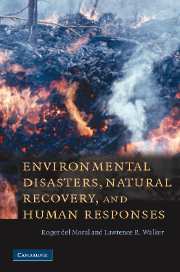Book contents
- Frontmatter
- Contents
- Preface and acknowledgements
- 1 Introduction: a crescendo of destruction
- 2 Natural disturbances: synergistic interactions with humans
- 3 Infertile and unstable habitats
- 4 Infertile and stable habitats
- 5 Fertile and unstable habitats
- 6 Fertile and stable habitats
- 7 The lessons learned
- Glossary
- Illustration credits
- Index
- Plate section
- References
2 - Natural disturbances: synergistic interactions with humans
Published online by Cambridge University Press: 11 September 2009
- Frontmatter
- Contents
- Preface and acknowledgements
- 1 Introduction: a crescendo of destruction
- 2 Natural disturbances: synergistic interactions with humans
- 3 Infertile and unstable habitats
- 4 Infertile and stable habitats
- 5 Fertile and unstable habitats
- 6 Fertile and stable habitats
- 7 The lessons learned
- Glossary
- Illustration credits
- Index
- Plate section
- References
Summary
INTRODUCTION
Dramatic natural disturbances are sometimes so incomprehensible and so destructive to humans that we blame supernatural beings: lightning is Thor striking his hammer, hurricanes are controlled by Hanaka, volcanoes erupt capriciously at the whim of deities such as Vulcan or Pele, while Poseidon wreaks havoc by flooding dry land. As our understanding of cataclysmic forces such as hurricanes, volcanoes and flooding grows, we begin to grasp some of the mechanics of a disturbance. Progress has been made in predicting weather (especially hurricane trajectories), the likelihood of volcanic eruptions and even the timing and extent of floods. However, there is still much to learn about where, why and when disturbances occur. Some answers lie in global weather patterns or wobbles in the tilt of the earth. Yet, enough mysteries remain that supernatural causes provide attractive explanations for some. Whatever their mechanics, timing or ultimate causes, disturbances are as much a part of our lives as dawn and dusk, as inevitable as winter following autumn. It behooves us to try to understand disturbances in order to mitigate their negative impacts, or at least to learn when it is best to run away and when it is best to stay. Disturbances vary widely in size and destructiveness. They can be as small as one tree falling in your backyard or as large as the 2004 tsunami in the Indian Ocean. In this chapter, we outline the types of disturbance and clarify the definitions of disturbance.
- Type
- Chapter
- Information
- Publisher: Cambridge University PressPrint publication year: 2007



